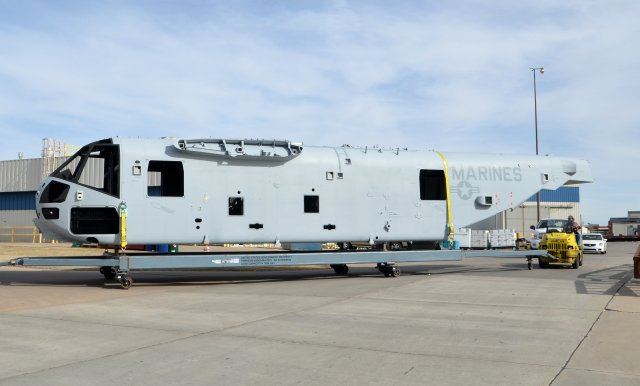Breaking news
Sikorsky takes delivery of the third fuselage for the CH-53K King Stallion helicopter program.
| a | |||
|
World Aviation Defense & Security Industry News - Spirit Aerosystems
|
|||
| Sikorsky takes delivery of the third fuselage for the CH-53K King Stallion helicopter program | |||
|
Spirit AeroSystems has successfully delivered to Sikorsky the third fuselage section for the CH-53K ‘King Stallion’ heavy lift helicopter program’s System Demonstration and Test Article (SDTA) contract. Consisting of an integrated cockpit and cabin structure with a separately attached tail section, the composite-skinned fuselage will enable prime contractor Sikorsky to begin assembling the third of four SDTA aircraft to further solidify the final production configuration of the CH-53K aircraft for the U.S. Marine Corps.
|
|||
|
|
|||
 Spirit AeroSystems has design and build responsibility on the composite fuselage for the Sikorsky CH-53K helicopter Spirit AeroSystems has design and build responsibility on the composite fuselage for the Sikorsky CH-53K helicopter(Credit: Spirit AeroSystems) |
|||
|
|
|||
|
“Spirit AeroSystems is pleased to be a major supplier to a new generation, heavy-lift helicopter capability for the Marine Corps,” said Phil Anderson, Spirit senior vice president of Defense Programs. “The strong, lightweight composite structures we are providing to Sikorsky will in turn give the Marine Corps a much needed increase in payload capability.”
The U.S. Marine Corps will employ the four SDTA aircraft to verify the helicopter’s design capability to carry 27,000 pounds over 110 nautical miles under “high hot” ambient conditions, tripling the external load carrying capacity of the current CH-53E Super Stallion helicopter. It will feature a new digital glass cockpit with fly-by-wire controls, a new elastomeric hub system, and composite rotor blades to improve "hot and high" performance. The split torque gearbox assembly weighs around 12,500 lb (5,670 kg); by itself heavier than a Blackhawk. The CH-53K will also include an improved external cargo handling system, survivability enhancements, and improvements to extend service life. The cabin will be 30 ft (9.14 m) long by 9 ft (2.74 m) wide by 6.5 ft (1.98 m) tall. Its cabin will be 1 ft (30 cm) wider and 15% larger, but will have new shorter composite sponsons. |
|||



















